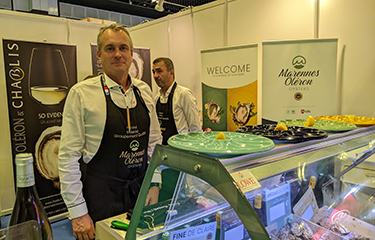French oysters continue to have a positive reputation in Asia, and unlike other seafood types the industry saw an uplift amid COVID-19.
Nicolas Brossard, speaking with SeafoodSource on behalf of Marennes Oleron Oysters during Seafood Expo Asia – running from 14 to 16 September in the Suntec Singapore Convention and Exhibition Centre – said the COVID-19 pandemic was a positive influence on they oyster business in France.
“COVID time was one of the best business activities for oyster farmers,” he said.
Because of lockdowns caused by the pandemic, he said, people gravitated toward higher quality goods in lieu of vacations or trips.
“Many people said they cannot go to holiday, they cannot go abroad, so they will eat better product, they will eat better things, and they will enjoy the food,” he said. “So oyster was one of the best choices for them.”
La Famille Boutrais owner Hugo Boutrais said oysters had an advantage thanks to the nature of the product – it is often consumed within a day or two of being harvested. Whereas frozen seafood and other large-quantity seafood items that have long lead times requiring anticipation of future events, oysters are on plates quick enough that major events won’t cause major issues.
“It’s out of the sea, and three days after it is on a Singapore menu and plate,” he told SeafoodSource.
As a result, French oyster companies fared well in the pandemic, and companies continue to market the premium product to importers in various parts of Asia.
“French gastronomic is very famous, so it is helpful for us,” Boutrais said. “In France we work very hard to make a famous oyster, and explain the oysters as well and explain what is the difference.”
For Boutrais, the Asian market represents a significant portion of the business, as much as 20 percent of the 1,000 metric tons the company brings to market.
Brossard said Marennes Oleron differentiates itself even within France with its unique method of cultivating oysters, resulting in some of the highest-end products on the planet. Initially raised at sea, the oysters in the region are then finished in special “claires” – man-made clay ponds that resemble salt marshes - in some cases in extremely low densities as low as two oysters per square meter.
Because of the lower density, the oysters grow faster, and because of the unique finishing environment the oysters take on unique qualities not seen in other oysters. The process, Brossard said, is unique and done only in the Marennes Oleron area and build upon a tradition with roots thousands of years old.
Now, post-COVID, Brossar and the Marennes Oleron oyster farmers are working to re-establish relationships in Asia, he said.
“The problem is during COVID, export relations with the client was impossible. I think we have to promote more, we have to do more things now in Asia to reach a good level,” he said.
Still, the Asian oyster market remains one of the most important ones for French oysters.
“Regarding the Asian market, it’s one of the biggest markets for oysters, this is 100 percent true, they love oysters,” he said.
Photo by Chris Chase/SeafoodSource







